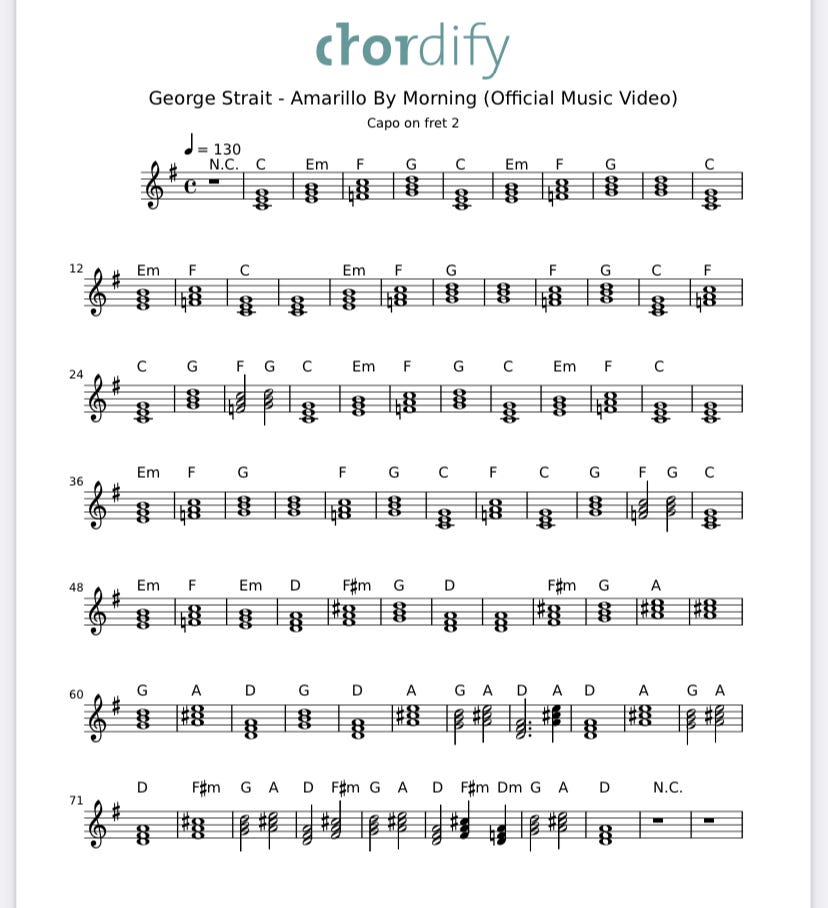Last week’s rando lyrics: “Squeeze Box”, The Who, 1975
Ed. The last couple of weeks I’ve had to move stuff from the Thursday post to the Friday post because I get a warning the post is “over email length”. This is not a Substack thing, it’s a Google thing for .gmail email addresses. Google limits the length or size of emails, and since many of my subscribers use Gmail, I don’t want you to receive a truncated post.
Welcome to the Regular Friday Post!
Last week we started down a perilous road into “Music Theory” (imagine an ominous crash of thunder with lightning outside the windows in a mysteriously black and white setting - clearly foreshadowing: trouble….
Let me go back a moment to last week’s post and something I was somewhat flippant (that’s a great word, btw…) about. I wrote: “I once did read the actual reason “why there aren’t accidentals in those two places” in an article, so there apparently is a reason, but it was kinda stupid and boring, so I forgot.”
I did forget, and frankly I still find it a little stupid and boring, but that’s not entirely fair, either. There is a reason, it’s old and kinda moldy, but when it’s explained in a cool video by a gentleman with a soothing British accent, it’s less so:
Last week I also provided a link for those who wished to know more about scales and their construction in a non flippant manner. Well, just like Diatonic and non Diatonic notes and chords, we’ve got both kinds here, so here's a non flippant written version on that subject (and some others, for fun…) Keys and key signatures
Last week we also touched on how scales become keys. I think the simple answer is that we build chords off of the notes in a scale using a different “formula” than the one we use for constructing a scale in the first place. The link to the web page above introduces a reason for scales, and the resultant keys, and why a key has it’s own unique formula for structure. We’ll get to that in a bit.
First, a basic Triad Chord that’s native (Diatonic) to a key is built from a note that’s diatonic to the scale. We start with the “C” scale because it’s the only scale that’s made up of Natural notes, the white keys on a piano. So, the C Scale is C,D, E, F, G, A, and B. Add the next higher C to the 7 notes of the scale and it’s then called an Octave. Starting with the C note, we build a C chord starting with the root C, then adding a Major Third above, which is E, and then a Perfect Fifth above the C, which is G. So that’s a CMaj chord, C-E-G, which we can play like this:
Note the low E is not played in this chart. It could be though, because the E, as we see, is a note in the CMaj chord, but it would then be in what’s called an “inversion”, which means out-of-order in the chord’s technical structure, which is another reason why music theory can be “complicated”….
The root C is on the A string, the Major Third E is on the D string, the Perfect Fifth G is the open G string, the C played on the B string is an Octave and the open E is a major 3rd above the octave, but…. (Ed. In a way, it’s a sort of an “add10” chord but I really don’t want to go there today because that’s sorta thought of as a “Third raised an octave”, rather than an “Third added to an octave”. This is why music theory can result in headaches and some things that reside in dark corners should not be looked at too carefully…. but go ahead, shine a light on the thing lurking over there if you want to: Jazz Has An Explanation, But It's Painful)
You could also go here (it’s also painful, but in a British accent, so…):
So, the formula for a Key, that transforms a scale to a key, is this:
Major, minor, minor, Major, Major, minor, diminished - where the minor chords are just triads with a flatted third, and the diminished chord is a triad with a flatted third and a flatted fifth. Keys can be written conventionally as the I, ii-, iii-, IV, V, vi-, vii(dim), and may be spoken as the 1, 2, 3, 4, 5, 6, 7 where it’s understood the 2, 3 and 6 are minor chords, the 1, 4, and 5 are Major, and the 7 is a diminished chord, (which almost no one uses anyway), and you can say things like “go to the 2”, or “go to the 2 chord”. But, if we say “go to the 2nd”, or “go to the 5th”, we’re usually talking about the note in the scale. Despite that, when playing in a band, everybody has to agree on some convention for talking to each other, and it’s all customized dialect at that point.
As above, minor chords are triads with a minor (or “flatted”) third instead of a Major third, and a diminished chord is a triad with both a flatted third and a flatted fifth. Diminished chords sound odd to us now, but they were once a staple of music because of the last thing we’re going to talk about theory wise today: Musical Tension
Musical tension is, very simplified, the feeling we get when we want musical tones to “resolve”. It’s probably cultural in nature, but essentially, the farther “away” from the root of the scale or key, the more “tension” we sort of feel, and when a song resolves to the root note or chord, we feel satisfied somehow. That’s why a lot of rock, pop, country, modern music in general uses something like a V, IV, I chord resolution in structures, especially in outros. We feel the melody or harmonies are “resolved”, sorta like Happy Gilmore telling his golf ball to get in the cup because it’s the golf ball’s “home”. Yeah, sorta.
Anyway, there are names for these resolutions. One is the name of the resolution between the dissonant vii(dim) chord and the tonic chord - it’s why the 7(dim) is also known as the “Leading Tone” - it “leads” us to resolve on the I. The V-I resolution is called the “Authentic” resolution (or cadence), and a IV-I resolution is called the “Plagal” or “Church” resolution or cadence, because the latter sort of has that “Amen” feel to it. In Western music we’ve been conditioned, or we somehow culturally “learned”, to hear the scale or key of a song, and the resultant “tension” between the root/tonic and each note that’s higher or lower note (that is, “away” from the root). We call that “musical tension” and that tension can be resolved by returning to the root, but sometimes for effect, songs will not resolve to the root, somewhat scandalously instead ending on the IV or other “non root”, or maybe even a non diatonic note or chord (Ed. Horrors! - it ain’t your great grandma’s music anymore….).
Music is interesting for a lot of reasons, and “tension” is one of them.
Disclaimer: This Substack is free, always will be, and I receive no compensation or other benefit (except the unsolicited, occasional, and much appreciated shoutout from readers and other Substackers!) from any of the people or companies or products I link to or write about. Note some images and other material may be copyrighted by the original author or composer and appear here under the “Fair Use” doctrine. Link: Fair Use Note also I do not use any form of artificial intelligence in writing Michael Acoustic. It is possible that some external sources that I link to or quote, do use or contain AI generated material.
Michael Acoustic
Thanks new Subscribers!!!!!! Mika, the Cat, welcomes you!!
This Week’s Conversation With Mika:
Me: “You’re grounded for jumping off the deck railing! You could have been hurt! Why did you do that?”
Mika: “Because I can. It was fun! You should try it. Like, right now, biped…”
Me: sigh…
Links: (Ed. as above, I ran out of space yesterday for links related to “Thursday stuff”, so today’s links are a mashup of both days)
A friend has been learning to play the harmonica. I had no idea they were tuned in different keys, but they are. Pretty interesting:
From Mr. Griff Hamlin, Blues Guitar Unleashed:
From guitarplayer.com:
From Carvin Audio:
From the Disc Makers Blog:
From American Songwriter:
From Reverb:
Other Voices:
Other Voices Too:
A Song To Play:
Amarillo By Morning (Link - It’s American Songwriter, so maybe a paywall, dunno)
Chord Chart
4/4 time, Key of AMaj pretty quick 130 BPM, but Capo on 2 to play a bit more easily using GMaj shapes , though still probably not a beginner song:
Lyrics from Genius - Note the structure: there are no choruses, just verses and an outro
[Verse 1]
Amarillo by morning, up from San Antone
Everything that I got is just what I've got on
When that sun is high in that Texas sky
I'll be buckin' at the county fair
Amarillo by morning
Amarillo, I'll be there
[Verse 2]
They took my saddle in Houston, broke my leg in Santa Fe
Lost my wife and a girlfriend, somewhere along the way
Well, I'll be lookin' for eight when they pull that gate
And I hope that judge ain't blind
Amarillo by morning
Amarillo's on my mind
[Verse 3]
Amarillo by morning, up from San Antone
Everything that I got is just what I've got on
I ain't got a dime, but what I got is mine
I ain't rich, but Lord, I'm free
Amarillo by morning
Amarillo is where I'll be
[Outro]
Amarillo by morning
Amarillo is where I'll be
Shameless self promotion section
My song is out! “Long Road Back” (click on link for streaming options)
What I’m Listening2:
(Ed. Mr. McCollim is who I learned music theory from at a local community college. A fantastic musician and keyboardist, he’s also an audio engineer, a great instructor, and an all around good guy!)
Cheers and keep playing!!
Michael Acoustic
“It’s never really final - you just run out of things you can bear to change…”








Thanks Mike!!!
“If you arranged the notes a semitone apart on a piano your hand could play wider chords.” Well, I never thought about THAT before. Whoa.
Would love help on modal scale if you’re ever so inclined. I completely don’t get what’s going on there.